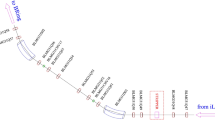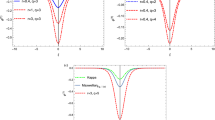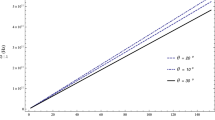Abstract
The interaction of 450-GeV protons with copper, which is the material of the collimators of the Large Hadron Collider, has been theoretically studied. A theoretical model for the formation and propagation of shock waves has been proposed on the basis of the analysis of the energy released by a proton beam in the electronic subsystem of the material owing to the deceleration of secondary particles appearing in nuclear reactions induced by this beam on the electronic subsystem of the material. The subsequent transfer of the energy from the excited electronic subsystem to the crystal lattice through the electron-phonon interaction has been described within the thermal spike model [I.M. Lifshitz, M.I. Kaganov, and L.V. Tanatarov, Sov. Phys. JETP 4, 173 (1957); I.M. Lifshitz, M.I. Kaganov, and L.V. Tanatarov, At. Energ. 6, 391 (1959); K. Yasui, Nucl. Instrum. Methods Phys. Res., Sect. B 90, 409 (1994)]. The model of the formation of shock waves involves energy exchange processes between excited electronic and ionic subsystems of the irradiated material and is based on the hydrodynamic approximation proposed by Zel’dovich [Ya.B. Zel’dovich and Yu.P. Raizer, Physics of Shock Waves and High-Temperature Hydrodynamic Phenomena (Nauka, Moscow, 1966; Dover, New York, 2002)]. This model makes it possible to obtain the space-time distributions of the main physical characteristics (temperatures of the ionic and electronic subsystems, density, pressure, etc.) in materials irradiated by high-energy proton beams and to analyze the formation and propagation of shock waves in them. The nonlinear differential equations describing the conservation laws of mass, energy, and momentum of electrons and ions in the Euler variables in the case of the propagation of shock waves has been solved with the Godunov scheme [S. K. Godunov, A.V. Zabrodin, M.Ya. Ivanov, A.N. Kraiko, and G.P. Prokopov, Numerical Solution of Multidimensional Problems in Gas Dynamics (Nauka, Moscow, 1976) [in Russian]]. The temperature, pressure, and specific internal energy have been calculated independently and separately for the ionic and electronic subsystems of the irradiated material. The formation of shock waves in copper has been simulated in the cylindrical geometry for various sizes and various types of the beam: for a needle beam (the distribution of protons in the beam is described by the Dirac delta function) and beams with a finite radius (0.3, 3, and 5 mm) with a Gaussian distribution of protons near the axis of the beam. The effect of the size and geometry of the proton beam, as well as of the form of the chosen boundary conditions, on the intensity of shock waves formed in copper and on change in their physicomechanical properties in the space and time has been revealed in the numerical simulation results.
Similar content being viewed by others
References
A. I. Ryazanov and E. V. Semenov, J. Exp. Theor. Phys. 111, 392 (2010).
A. I. Ryazanov, E. V. Semenov, R. Assmann, and A. Ferrari, CERN-ATS-Note-2010-041 MD (CERN, Geneva, 2010), p. 40.
Ya. B. Zel’dovich and Yu. P. Raizer, Physics of Shock Waves and High-Temperature Hydrodynamic Phenomena (Nauka, Moscow, 1966; Dover, New York, 2002).
N. A. Tahir, A. Kozyreva, P. Spiller, D. H. H. Hoffmann, and A. Shutov, Phys. Rev. E: Stat., Nonlinear, Soft Matter Phys. 63, 036407 (2001).
N. A. Tahir, R. Schmidt, A. Shutov, I. V. Lomonosov, A. R. Piriz, D. H. H. Hoffmann, C. Deutsch, and V. E. Fortov, Phys. Rev. E: Stat., Nonlinear, Soft Matter Phys. 79, 046410 (2009).
I. M. Lifshitz, M. I. Kaganov, and L. V. Tanatarov, Sov. Phys. JETP 4, 173 (1957).
I. M. Lifshitz, M. I. Kaganov, and L. V. Tanatarov, At. Energ. 6, 391 (1959).
K. Yasui, Nucl. Instrum. Methods Phys. Res., Sect. B 90, 409 (1994).
E. V. Metelkin and A. I. Ryazanov, J. Exp. Theor. Phys. 90, 370 (2000).
A. I. Ryazanov, S. A. Pavlov, E. V. Metelkin, and A. V. Zhemerev, J. Exp. Theor. Phys. 101, 120 (2005).
A. Fasso et al., in Proceedings of the Conference for Computing in High Energy and Nuclear Physics (CHEP 2003), La Jolla, California, United States, March 24–28, 2003 (La Jolla, 2003).
S. K. Godunov, A. V. Zabrodin, M. Ya. Ivanov, A. N. Kraiko, and G. P. Prokopov, Numerical Solution of Multidimensional Problems in Gas Dynamics (Nauka, Moscow, 1976) [in Russian].
Author information
Authors and Affiliations
Corresponding author
Additional information
Original Russian Text © A.I. Ryazanov, A.V. Stepakov, Ya.S. Vasilyev, A. Ferrari, 2014, published in Zhurnal Eksperimental’noi i Teoreticheskoi Fiziki, 2014, Vol. 145, No. 2, pp. 205–217.
Rights and permissions
About this article
Cite this article
Ryazanov, A.I., Stepakov, A.V., Vasilyev, Y.S. et al. Theoretical study of the effect of the size of a high-energy proton beam of the Large Hadron Collider on the formation and propagation of shock waves in copper irradiated by 450-GeV proton beams. J. Exp. Theor. Phys. 118, 176–186 (2014). https://doi.org/10.1134/S1063776114010269
Received:
Published:
Issue Date:
DOI: https://doi.org/10.1134/S1063776114010269




